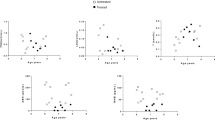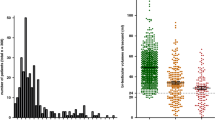Abstract
In a long-term follow-up study we compared preoperative testicular position, age at orchiopexy, and morphology of testicular biopsies investigated at orchiopexy to sperm analysis results, testicular volume, and serum follicle-stimulating hormone and luteinizing hormone levels at follow-up in 46 men with a history of surgical correction of cryptorchidism in childhood. They had undergone orchiopexy at age 1.5–12.0 years, 24 for unilateral and 22 for bilateral cryptorchidism. Eleven (46%) of the 24 patients with unilateral and 7 (32%) of the 22 with bilateral undescended testes had a normal sperm analysis, whereas in men with impaired spermiogenesis oligo-asthenozoospermia was the predominant feature. Three (13.6%) patients with bilateral cryptorchidism showed azoospermia, but none of the patients with unilateral cryptorchidism did. Neither the age at orchiopexy nor the average germ-cell count per cross-sectioned seminiferous tubule of testicular biopsies examined at orchiopexy correlated significantly with subsequent sperm analysis results or gonadotropin levels at follow-up. The pretreatment testicular position (“testicular position value”) has a high prognostic value for prediction of subsequent sperm analysis results and serum gonadotropin levels.
Similar content being viewed by others
References
Abramssn L, Duchek M (1989) Gonadotropins, testosterone and prolactin in men with abnormal semen findings and an evaluation of the hormone profile. Int Urol Nephrol 21: 499–510
World Health Organization (1992) WHO laboratory manual for the examination of human semen and sperm-cervical mucus interaction. Cambridge University Press, Cambridge, 1–106
Bollerslev J, Rohl H, Krag-Sorenson E, Bennet P (1986) Gonadotropin and androgen levels in patients operated upon for cryptorchidism. Dan Med Bull 33: 336–338
Bremholm-Rasmussen T, Ingerslev HJ, Hostrup H (1988) Bilateral spontaneous descent of the testis after the age of 10: subsequent effects on fertility. Br J Urol 75: 820–823
Carlsen E, Giwercman AJ, Keiding N, Shakkebaek NE (1993) Decline in semen quality from 1930 to 1991. Ugeskr Laeger 155: 2530–2535
Chilvers C, Dudley NE, Gough MH, Jackson MB, Pike MC (1986) Undescended testis: the effect of treatment on subsequent risk of subfertility and malignancy. J Pediatr Surg 21: 691–696
Cortes D, Thorup J, Frisch M, Moller H, Jacobsen GK, Beck BL (1994) Examination for intratubular germ cell neoplasia at operation for undescended testis in boys. J Urol 151: 722–725
D'Agostino S, Zen F, Ioverno E, Pesce C, Belloli G (1993) Cryptorchidism and fertility: an assessment in adulthood. Pediatr Med Chir 15: 275–278
Fallon B, Kennedy TJ (1985) Long-term follow-up of fertility in cryptorchid patients. Urology 25: 502–504
Gilhooly PE, Meyers F, Lattimer JK (1984) Fertility prospects for children with cryptorchidism. Am J Dis Child 138: 940–943
Hadziselimovic F (1982) Pathogenesis and treatment of undescended testes. Eur J Pediatr 139: 255–265
Hadziselimovic F, Hecker E, Herzog B (1984) The value of testicular biopsy in cryptorchidism. Urol Res 12: 171–174
Hadziselimovic F, Herzog B (1990) Hodenerkrankungen im Kindesalter. Hippokrates, Stuttgart, 23–105
Halme A, Kellokumpu-Lehtinen P, Lehtonen T, Teppo L (1989) Morphology of testicular germ cell tumours in treated and untreated cryptorchidism. Br J Urol 64: 78–83
Hutson JM, Beasley SW (1992) Descent of the testis. Edward Arnold, London Melbourne Auckland, pp 103–105
Jequier AM, Holmes SC (1993) Primary testicular disease presenting as azoospermia or oligospermia in an infertility clinic. Br J Urol 71: 731–735
Jones BJ, Thornhill JA, O'Donnell B, Kelly DG, Walsh A, Fennelly JJ, Fitzpatrick JM (1991) Influence of prior orchiopexy on stage and prognosis of testicular cancer. Eur Urol 19: 201–203
Lee PA (1993) Fertility in cryptorchidism. Does treatment make a difference? Endocrinol Metab Clin North Am 22: 479–490
Lee PA, Bellinger MF, Songer NJ, O'Leary L, Fishbough R, LaPorte R (1993) An epidemiologic study of paternity after cryptorchidism: initial results. Eur J Pediatr 152 [Suppl 2]: 25–27
Lenz S, Giwercman A, Elsborg A, Cohr KH, Jelnes JE, Carlsen E, Skakkebaek NE (1993) Ultrasonic testicular texture and size in 444 men from the general population: correlation to semen quality. Eur Urol 24: 231–238
Mandat KM, Wieczorkiewicz, Gubata-Kacata M, Sypniewski J, Bujok G (1994) Semen analysis of patients who had orchidopexy in childhood. Eur J Pediatr Surg 4: 94–97
Mengel W, Wronecki K, Zimmerman FA (1981) Comparison of the morphology of normal and cryptorchid testes. In: Fonkalsrud EW, Mengel W (eds) The undescended testis. Yearbook Medical Publisher, London, pp 57–74
Myers NA, Officer CB (1975) Undescended testes: congenital or acquired? Aust Paediatr J 11: 76–80
Puri P, O'Donnell B (1988) Semen analysis of patients who had orchidopexy at or after seven years of age. Lancet II: 1051–1052
Puri P, O'Donnell B (1990) Semen analysis in patients operated on for impalpable testes. Br J Urol 66: 646–647
Scheiber K, Marberger H, Bartsch G (1983) Exocrine and endocrine testicular function in patients with unilateral testicular disease. J R Soc Med 76: 649–651
Schirren C (1982) Praktische Andrologie. Karger, Basel München Paris, 1–72
Schoemaker J (1932) Über Kryptorchismus und seine Behandlung. Chirurg 4: 1–3
Urry RL, Carrell DT, Starr NT, Snow BW, Middleton RG (1994) The incidence of antisperm antibodies in infertility patients with a history of cryptorchidism. J Urol 151: 381–383
Welkowitz J, Ewen RB, Cohen J (1982) Introductory statistics for the behavioral sciences, 3rd edn. Harcourt Brace Jovanovich, Orlando, pp 157–214
Zer M, Wolloch Y, Dintsman M (1975) Staged orchiorrhaphy. Arch Surg 110: 387–390
Author information
Authors and Affiliations
Rights and permissions
About this article
Cite this article
Mayr, J., Pusch, H.H., Schimpl, G. et al. Semen quality and gonadotropin levels in patients operated upon for cryptorchidism. Pediatr Surg Int 11, 354–358 (1996). https://doi.org/10.1007/BF00497811
Accepted:
Published:
Issue Date:
DOI: https://doi.org/10.1007/BF00497811




